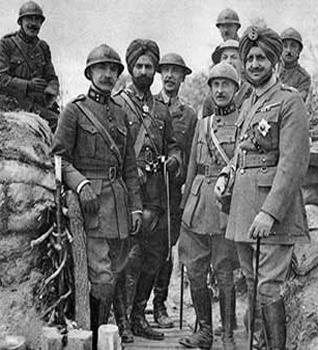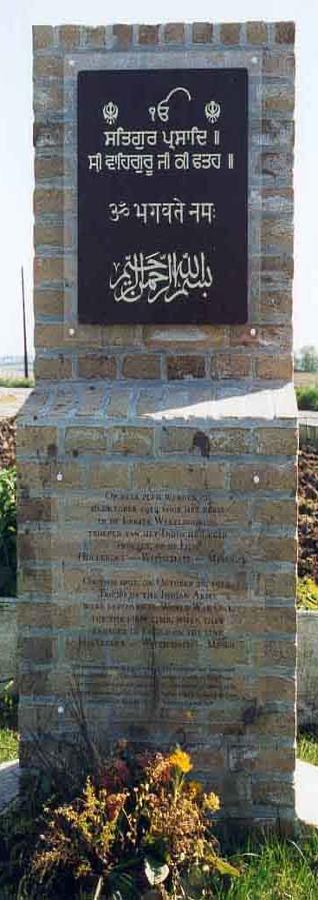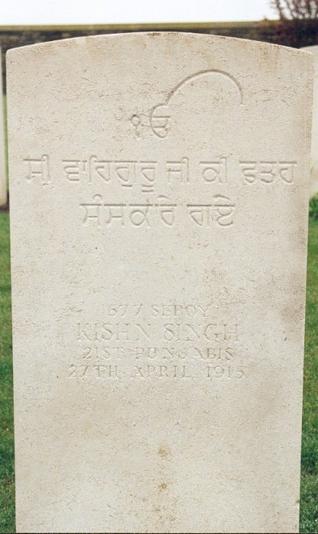
Image above: Maharaja of Patiala - Lt. Gen. Bhupinder Singh - inspects WWI troops at Flanders in 1915. Below, 2nd from below - memorial in Hollebeke, Belgium. 3rd: historian S. Bhupinder Singh Holland with Belgian dignitaries at a remembrance cerremony.



The Sikhs of Sint-Truiden, Belgium
by FLANDERS TODAY
Editor's Note: The soil of Belgium has been irrigated with the blood of thousands of the bravest of Sikh Soldiers shed there over the course of the two World Wars. The following is the story of Sikhs who have now made their home in those same cities, towns and villages as citizens of a country their ancestors gave so much to liberate.
A Limburg town in Belgium is tackling
the issues of multi-culturalism head on by bringing its secondary
school students face-to-face with cultures who call the region home
It was 1972 when the first Sikhs arrived in Flanders to make it their home. All male
political refugees, they had been expelled from Uganda by Idi Amin.
Many more arrived in 1984, fleeing India after the bloody June massacre
of thousands of followers of Sikhism by Indian troops at the Golden
Temple in Amritsar.
The storming of the Golden Temple followed weeks of growing tension
between the government of Indira Gandhi and Sikhs in
Punjab, who believed they were being discriminated against by the Hindu
majority. A consequence of the massacre was the assassination of Gandhi
herself later the same year by her own two Sikh bodyguards. Anti-Sikh pogroms
followed, leading to their emigration in large numbers.
Apart from a few exceptions, the Sikhs arriving in Flanders were
mainly poorly educated labourers. Accustomed to working in the fields,
they soon found employment in the agriculture sector, particularly in
Limburg where they worked on the many fruit farms in the Haspengouw
region.
Some showed more of a commercial aptitude, and their night shops and
DVD rental outlets were readily patronised by the locals. It wasn't
long before the Sikh men brought families over from the Punjab region
and established what are now thriving Sikh communities.
There are currently about 8,000 Sikh-Belgians in Flanders, with a particular
concentration in the Limburg town of Sint-Truiden. In 1993 in Halmaal,
on the outskirts of Sint-Truiden, a former farmhouse was converted into
a hurdwara: Gurdwara Sangat Sahib.
The gurdwara (a Punjabi word meaning house of worship) is the focal
point for the large Sikh community in Sint-Truiden, which swells to
over 1,000 during the fruitpicking season. Here they come together to
pray, read from their scripture (the Guru Granth Sahib), celebrate
births and weddings and enjoy a communal meal every Sunday.
In the gurdwara in Halmaal, thick carpets cover the floor; the roof
and walls are decorated with orange and red garlands; and the Guru
Granth Sahib is given a prominent position on a raised platform, covered
by an ornately decorated canopy. People of any - or no - religious
faith are welcome in Gurdwara Sangat Sahib. Before entering, visitors
must remove their shoes and socks and cover their head with one of the
orange scarves provided at the door.
Teaching tolerance
Of course, it hasn't always been easy. Soon after the gurdwara was
established in Halmaal, Sikh agricultural workers reported being
repeatedly harassed and intimidated. A house where 10 Sikhs lived was
damaged by a fire-bomb, and a Sikh was shot in the arm.
In recent years, efforts have been made from both the Sikh community
and local government towards greater integration and understanding.
Louke Bamps regularly puts this into practice. A former council worker
involved in helping political refugees, she has come to know and love
the Sikh community and to follow their lifestyle and beliefs to some
degree. She is also a fount of knowledge on Sikhism and regularly gives
guided tours around Gurdwara Sangat Sahib, including an introduction to
Sikhism.
"The Sikhs in Limburg are very peaceful, tolerant and respectful,"
says Bamps. "Many of them have become proficient in Dutch, and a lot of
Sikh families have had children in recent years, who are becoming well
integrated in the schools. What's more, Sikhs make an important
contribution to the economy of Limburg, thanks to their willingness to
work hard on farms and in factories and in the shops they have
established."
Bamps is involved with Hapje Sint-Truiden, a brand-new project
focusing on diversity and tolerance aimed at students in the first year
of secondary schools. It's a joint initiative between Djapo, an NGO
that strives to encourage world citizenship and sustainable development
in the classroom, and the Integration Department of Sint-Truiden.
"It's an important and very useful initiative," says Sint-Truiden
mayor Ludwig Vandenhove. "Its objective is to give pupils between 12
and 13 a taste of other cultures in Sint-Truiden. Children from various
local schools will be spending significant time with four of our local
communities: Sikhs, Moroccans, Nepalese and Ahmadiyya Muslims from
Pakistan."
In the Gurdwara
Last month, it was the turn of 20 children from the Zonnegroen School
in Zoutleeuw (plus one reporter) to visit the Gurdwara Sangat Sahib in
Halmaal. Once the students had overcome their initial inconvenience of
having to remove their shoes and wear scarves, it was a great success.
Food, of course, is always a good way to break down those cultural
barriers. We were all warmly welcomed with masala chai (a sweet, spiced
milk-based tea) and pakoras (vegetables like onion, cauliflower and
potato, fried in a flour batter). The children then sat surprisingly
quietly in the gurdwara and listened to Bamps give an overview of
Sikhism. This was followed by a group of Sikhs playing traditional instruments and singing hymns from their scripture.
Then it was time for lunch, and we all sat cross-legged on carpets to
enjoy a typical Punjabi meal. There were a few anxious faces when the
first exotic-looking ladles of dahl (thick lentil stew) and sabzi
(vegetables with homemade cheese) were served. However, once it was
realised that the food was not too spicy, the rice marvellously scented
and the raita (yogurt and mint) very tasty, appetites returned and
many of the children were happy to accept second helpings (particularly
of the pancake-like rotis).
The mayor also popped in to see how the event was going. He answered
the children's questions and emphasized the need for integration and
tolerance among the different communities in Sint-Truiden: "I am very
pleased to see the project progressing successfully. It shows that it is
worth taking the effort to understand different cultures and faiths.
And sharing a meal is one of the best ways to break down barriers and
prejudices. With this project, Sint-Truiden is taking an important lead
in the area of multi-cultural integration in Flanders."
May 9, 2010


